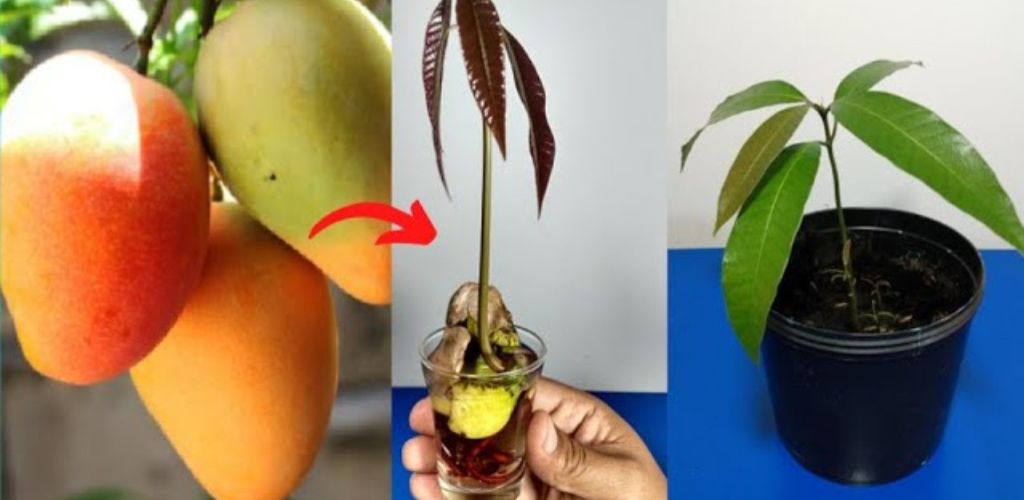How to sprout a simple mango pit into a majestic plant?
Understand the nature of the mango grain and its needs.
Before embarking on growing a mango seed, it is important to familiarize yourself with its characteristics and requirements.
Mango (Mangifera indica) is a tropical fruit native to India and Burma. It belongs to the Anacardiaceae family, which also includes pistachios and cashews.
Growing a mango pit requires warmth, humidity, good light and well-drained soil.
At the heart of the fruit is the mango seed, which encloses the seed. This seed is protected by a rigid woody shell called an endocarp . To access the seed, it is necessary to remove this shell.
This step must be done carefully, because the young roots and germ are fragile and can be damaged.
Preparing the mango pit: a crucial step
Once you have tasted the mango, it is time to prepare the hole for planting.
First of all, it should be gently cleaned with water to remove all traces of pulp. Next, use a sharp knife to cut the endocarp along its edges, without cutting into the seed.
Be careful not to injure yourself during this operation. Once the shell has been removed, the seed should be soaked in a bowl of warm water for 24 hours.
This step is essential to stimulate seed germination and promote root emergence.
Germination system setup
There are several methods to germinate a mango seed, but the plastic bag technique is particularly effective and simple to implement.
It consists of creating a humid and warm environment conducive to germination, using a plastic bag and absorbent paper.
After soaking the seed, wrap it in several layers of moistened paper towels. Make sure the paper is damp, but not soaked, to avoid the risk of mold formation.
Then place the wrapped seed in a plastic bag and seal it tightly. The bag should be kept at a temperature between 25 and 30° C. You can, for example, place it near a radiator or on a sunny window sill. The seed should germinate in 10 to 20 days.
Planting and caring for the young mango plant.
When the roots have reached a length of about 5 centimeters, it is time to plant the seed.
Choose a pot 20 to 30 centimeters in diameter, perforated with holes to ensure good drainage. Fill the pot with a mixture of equal parts potting soil and sand, and plant the seed 2 to 3 centimeters deep, making sure the roots are well covered with soil.
Water well, then place the pot in a bright, warm place, away from drafts.
The ideal temperature for the growth of young mango plants is between 20 and 30°C.
The first leaves should appear within a few weeks of sowing. To promote the growth of the plant, it is recommended to provide it with a liquid fertilizer rich in nitrogen, phosphorus and potassium, according to the manufacturer’s instructions. Watering should be regular, taking care not to waterlog the pot and letting the substrate dry between two waterings.
As the plant grows, it is possible to transplant it into a larger pot and offer it a stake to support its stem.
Challenges and precautions for growing the mango plant
Growing a mango plant from a hole requires patience, attention and some precautions.
First of all, it is important to ensure that the temperature and humidity conditions are stable and optimal, to promote plant growth.
It is also essential to protect the young plant from pests and diseases, in particular by avoiding excess water which can encourage the development of fungi.
It’s also worth keeping in mind that growing a mango plant indoors presents challenges, especially when it comes to pollination and fruiting.
In their natural habitat, mango flowers are pollinated by insects or bats, which can be difficult to replicate indoors.
Furthermore, even if the plant reaches a sufficient size to produce flowers, it may not bear fruit or the fruits may not be of good quality.
Finally, it is important to note that growing a mango plant from a hole can be a rewarding and rewarding experience, but the plant may never produce fruit.
Much depends on the mango variety and growing conditions. However, even without fruit, the beauty and elegance of the mango plant make it a decorative element of choice for your interior.
Growing a mango pit is an exciting adventure that requires patience and attention, but can give you the satisfaction of watching a majestic plant emerge and grow. By following the steps and tips presented in this article, you will put the odds in your favor to succeed in this business and perhaps one day taste the fruits of your own mango.
